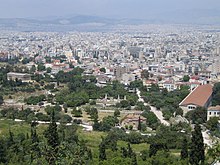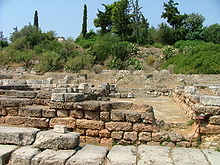Ancient Agora of Athens: Difference between revisions
ClueBot NG (talk | contribs) m Reverting possible vandalism by 24.207.79.208 to version by Greco22. False positive? Report it. Thanks, ClueBot NG. (1684024) (Bot) |
|||
| Line 44: | Line 44: | ||
The '''Ancient Agora of [[Classical Athens]]''' is the best-known example of an ancient Greek [[agora]], located to the northwest of the [[Acropolis of Athens|Acropolis]] and bounded on the south by the hill of the [[Areopagus]] and on the west by the hill known as the [[Colonos Agoraios|Kolonus Agoraios]], also called Market Hill.<ref>R. E. Wycherley, ''Literary and Epigraphical Testimonia (Athenian Agora)'' (American School of Classical Studies, 1957), pg. 27.</ref> |
The '''Ancient Agora of [[Classical Athens]]''' is the best-known example of an ancient Greek [[agora]], located to the northwest of the [[Acropolis of Athens|Acropolis]] and bounded on the south by the hill of the [[Areopagus]] and on the west by the hill known as the [[Colonos Agoraios|Kolonus Agoraios]], also called Market Hill.<ref>R. E. Wycherley, ''Literary and Epigraphical Testimonia (Athenian Agora)'' (American School of Classical Studies, 1957), pg. 27.</ref> |
||
==History== |
==History== BOOBIES |
||
===Development=== |
===Development=== |
||
Revision as of 20:46, 11 March 2014
Αρχαία Αγορά της Αθήνας | |
 | |
| Alternative name | Forum of Athens |
|---|---|
| Location | Greece |
| Region | Attica |
| Coordinates | 37°58′30″N 23°43′21″E / 37.97500°N 23.72250°E |
| History | |
| Material | Marble |
| Founded | 6th century BC |
| Periods | Classical era |
| Cultures | Ancient Greece |
| Site notes | |
| Excavation dates | 1931 until today |
| Archaeologists | American School of Classical Studies at Athens |
| Condition | Ruined |
| Ownership | Public property |
| Management | Minister for Culture |
| Public access | Yes |

The Ancient Agora of Classical Athens is the best-known example of an ancient Greek agora, located to the northwest of the Acropolis and bounded on the south by the hill of the Areopagus and on the west by the hill known as the Kolonus Agoraios, also called Market Hill.[1]
==History== BOOBIES
Development
The agora was probably laid out in the center of the city as a public space in the 6th century BC,[2] though Laurence Baurain-Rebillard has suggested that it dates to the 7th century.[3] Earlier, a more primitive agora may have existed elsewhere in Athens.[4] The final site was located at the intersection of three existing roads with the Panathenaic Way, the main road in Athens.[5] It was organized by Peisistratus, who removed private houses from the agora, closed wells, and made it the center of Athenian government. He also built a drainage system, fountains and a temple to the Olympian gods. In the 5th and 4th century BC there were temples constructed to Hephaestus, Zeus and Apollo.[6]
Starting in 480 BC, the Second Persian invasion of Greece caused many Athenians to flee the city, leaving it largely abandoned. The city was almost completely destroyed, but the Athenians returned following the defeat of the Persians in 478, and the Agora was rebuilt.[7] There were no more major changes until the 2nd century BC when the east and south sides of the square were remodeled by wealthy foreign rulers.[8]
After an unsuccessful alliance with King Mithridates VI of Pontus in 86 BC, the fortified walls of Athens were heavily damaged. They were never rebuilt to their full previous strength. The Agora remained the center of Athens until 267 AD, when it was once again sacked, this time by invading Heruli; the weakened perimeter wall was not a sufficient defense. After fighting had ravaged much of the city, the Athenians quickly reconstructed the wall, but enclosed a much smaller area. The agora and the acropolis were left on the outside of the wall and were susceptible to further damage. This reconstructed wall is of great archaeological importance because it contains pieces of ruined buildings including Hadrian's Library and the Stoa of Attalos.[9] This event is documented by Dexippus, a historian and statesman from Athens. In 529, Pagan philosophical schools were closed by Justinian. After centuries of periodic barbarian invasion, the agora was abandoned after the Slavic invasion of the 6th century.[10]
Use in Antiquity
The agora was the center of political and public life in Athens. It was a large open area surrounded by buildings of various functions. The agora was utilized for commerce, political, religious and military activity.[11] Meetings were held four times per month to enact legislation, to hear embassies, and deal with defense of the city-state.[12] In addition, some public forums to discuss ostracism were held in the agora. The law courts were located there, and anyone who happened to be in the agora when a case was being heard would probably have been able to view the spectacle, though only those adult male citizens appointed by lot would have been able to serve as jurors. The agora was further the location of a temporary theater and of burial sites [13]
Buildings and structures of the classical agora


- Peristyle Court
- Mint
- Enneakrounos
- South Stoa I and South Stoa II
- Aiakeion
- Strategeion
- Colonos Agoraios
- Tholos
- Agora stone
- Monument of the Eponymous Heroes
- Metroon (Old Bouleuterion)
- New Bouleuterion
- Temple of Hephaestus (Hephaestion)
- Temple of Apollo Patroos
- Stoa of Zeus
- Altar of the Twelve Gods
- Stoa Basileios (Royal stoa)
- Temple of Aphrodite Urania
- Stoa of Hermes
- Stoa Poikile
Other Notable Monuments


A number of other notable monuments were added to the agora. Some of these included:
- The Middle stoa which was the most extensive monument built during the 100's B.C.E.[14]
- A small Roman temple was added in front of the Middle stoa.
- An Altar of Zeus Agoraios was added just to the east of the Monument to the Eponymous Heroes.[15]
- The Temple of Ares, dedicated to Ares, the god of war, was added in the north half agora, just south of the Altar of the Twelve Gods.[16]
- The Odeon of Agrippa and accompanying gymnasium were added in the centre of the agora.[17]
- The substantial Stoa of Attalos was built along the eastern edge of the agora.[18]
- A collection of buildings were added to the south-east corner: the East stoa, the Library of Pantainos, the Nymphaeum and a temple.
- There is evidence of a Synagogue in the Agora of Athens in the 3rd century.
- A statue of the Roman emperor Hadrian was located near the metroon.[19]
- The Temple of Zues Phratrios and Athena Phratria dated to the 300's B.C.E. and is located near the Temple of Apollo Patroos.[20]
- The south end of what is believed to be a Basilica has been uncovered near Hadrian Street and is dated to the mid 100's C.E.[21]
- The Monopteros was located south of the Basilica and also dated to the mid 100's C.E. It had no walls, was a dome supported by columns and was about 8 meters in diameter.[22]
- The Bema was a speakers platform and was located near the Stoa of Attalos.[23]
Excavations
The ancient Athenian agora has been excavated by the American School of Classical Studies at Athens since 1931 under the direction of T. Leslie Shear, Sr. They continue to the present day, now under the direction of John McK Camp.[1]
After the initial phase of excavation, in the 1950s, the Hellenistic Stoa of Attalos was reconstructed on the east side of the agora, and today it serves as a museum and as storage and office space for the excavation team.[2]
Museum of the Ancient Agora
The museum is housed in the Stoa of Attalos, and its exhibits are connected with the Athenian democracy. The collection of the museum includes clay, bronze and glass objects, sculptures, coins and inscriptions from the 7th to the 5th century BC, as well as pottery of the Byzantine period and the Turkish occupation.
See also
References
- ^ R. E. Wycherley, Literary and Epigraphical Testimonia (Athenian Agora) (American School of Classical Studies, 1957), pg. 27.
- ^ "The Athenian Agora." Overview: The Archaeological Site. N.p., n.d. Web. 04 Dec. 2012. <http://agathe.gr/overview/>.
- ^ Laurence Baurain-Rebillard, "Les vases “communicants” a Athenes, des offrandes de l’Acropole aux premiers banquets sur l’Agora," Ktema 23 (1998):125–136.
- ^ Wycherley, Literary and Epigraphical Testimonia (Athenian Agora), pg. 27.
- ^ John McK. Camp II, The Athenian Agora: Site Guide, 5th ed. (Princeton, N.J.: American School of Classical Studies, 2010).
- ^ Wycherley, Literary and Epigraphical Testimonia (Athenian Agora).
- ^ Wycherley, Literary and Epigraphical Testimonia (Athenian Agora), pg. 36.
- ^ Christopher B. Mee, Greek Archaeology: A Thematic Approach (Chichester, U.K.: Wiley-Blackwell, 2011), pg. 59.
- ^ Wycherley, Literary and Epigraphical Testimonia (Athenian Agora), pg. 23.
- ^ "The Athenian Agora." Overview: The Archaeological Site. N.p., n.d. Web. 04 Dec. 2012. <http://agathe.gr/overview/>.
- ^ "The Athenian Agora." Overview: The Archaeological Site. N.p., n.d. <http://agathe.gr/overview/>.
- ^ Mabel Lang, The Athenian Citizen: Democracy in the Athenian Agora (Agora picture book 4), Vol, IV (American School of Classical Studies, 2004), pg. 3.
- ^ Mee, Greek Archaeology: A Thematic Approach, pg. 62-67.
- ^ Camp, The Athenian Agora: Site Guide, pg. 168.
- ^ Camp, The Athenian Agora: Site Guide, pg. 65.
- ^ Camp, The Athenian Agora: Site Guide, pg. 110.
- ^ Camp, The Athenian Agora: Site Guide, pg. 114.
- ^ Camp, The Athenian Agora: Site Guide, pg. 123.
- ^ Camp, The Athenian Agora: Site Guide, pg. 63.
- ^ Camp, The Athenian Agora: Site Guide, pg. 73.
- ^ Camp, The Athenian Agora: Site Guide, pg. 93.
- ^ Camp, The Athenian Agora: Site Guide, pg. 118.
- ^ Camp, The Athenian Agora: Site Guide, pg. 122.
External links
- Hellenic Ministry of Culture: The Ancient Agora of Athens - official site with a schedule of its opening hours, tickets and contact information.
- Agora Excavations - American School of Classical Studies Agora excavation project.
- Map of the Agora of Athens in Socrates and Plato's time
- Agora of Athens in 421 BC
- The Athenian Agora: A Short Guide in Color
- The Athenian Agora. A Guide to the Excavation and Museum
- Reconstruction of the Athenian Agora in Google Earth
- Ministry of Culture: The Museum
- www.athensinfoguide.com The Museum
- Agora of Athens: photo album and description

